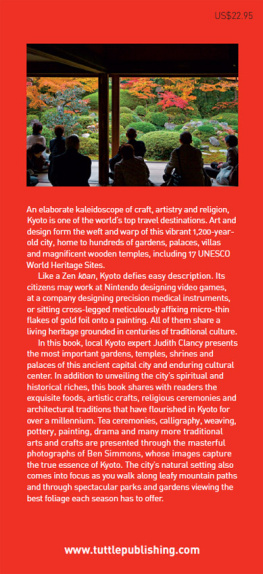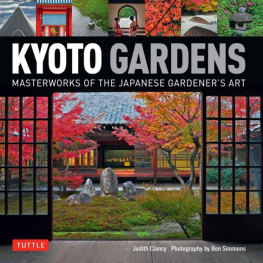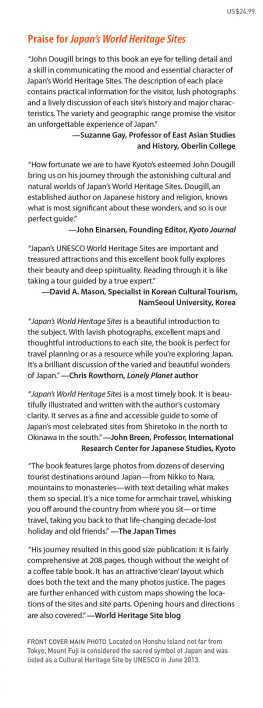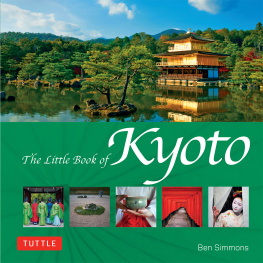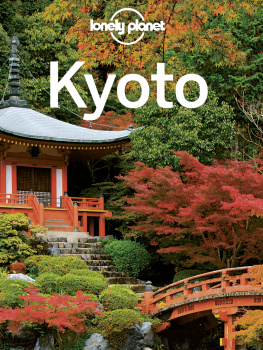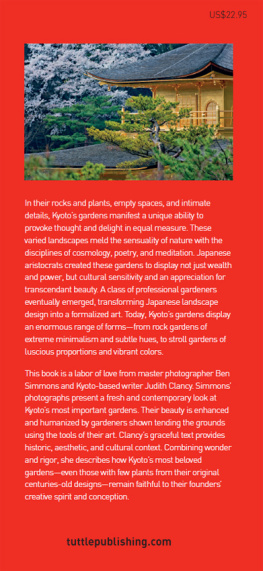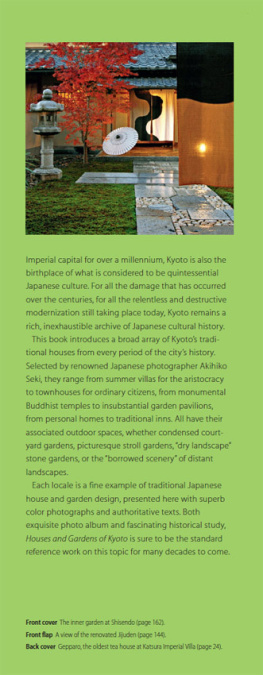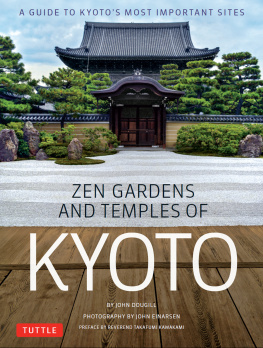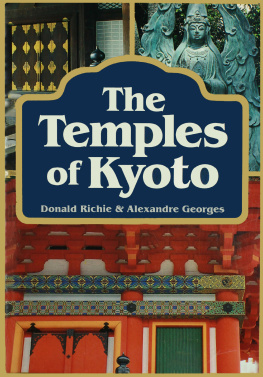BIBLIOGRAPHY
Barrow, John D., The Artful Universe , Oxford University Press, 1995.
Castile, Rand, The Way of Tea , Weatherhill, 1971.
Clancy, Judith, Exploring Kyoto , Stone Bridge Press, 2008.
Fieve, Nicolas and Waley, Paul (eds), Japanese Capitals in Historical Perspective , Routledge Curzon, 2003.
Fontein, Jan and Hickman, Money, l., Zen Painting and Calligraphy , Museum of Fine Arts, Boston, 1970.
Ishige, Naomichi, The History and Culture of Japanese Food , Kegan Paul, 2001.
Keane, Marc P., Japanese Garden Design , Charles E. Tuttle, 1996.
Kinoshita, June and Palevsky, Nicholas, Gateway to Japan , Kodansha, 1990.
Mertz, Mechtild, Wood and Traditional Woodworking in Japan , Kaiseisha Press, 2011.
Nishi, Kazuo and Kazuo, Hozumi, What is Japanese Architecture? , Kodansha, 1985.
Richie, Donald, A Tractate on Japanese Aesthetics , Stone Bridge Press, 2007.
Richie, Donald and Georges, Alexandre, The Temples of Kyoto , Charles E. Tuttle, 1995.
Sasaki, Rither Fuller (ed. Thomas Kirchner), The Record of Linji , University of Hawaii Press, 2008.
Seike, Kiyosi, The Art of Japanese Joinery , Weatherhill, 2007.
Shiffert, Edith, The Light Comes Slowly , Katsura Press, 1997.
Treib, Marc and Herman, Ron, The Guide to the Gardens of Kyoto , Shufunotomo, 1993.

An ancient priestly chore in an ancient shrine.

Below a calendar depicting the garden within, a pair of modest zori thong footwear sit on a shelf in a temples entrance.

KYOTOS MAIN HERITAGE SIGHTS
CENTRAL AND EASTERN KYOTO
1. Kyoto Imperial Palace, page
2. Nijo Castle, page
3. Heian Shrine, page
4. downtown Kyoto: Kawaramachi, Nishiki, Teramachi and Pontocho, page
5. Gion district, page
6. Kiyomizu Temple, page
7. Kennin-ji Temple, page
8. Nanzen-ji Temple, page
NORTHERN KYOTO
9. Ginkaku-ji, page
10. The Philosophers Path, page
11. Shisendo Temple, page
12. Shugakuin Imperial Villa, page *
13. Shimogamo Shrine, page
14. Kamigamo Shrine, page *
15. daitoku-ji Temple Complex, page
16. Mount Hiei, page *
17. Enryaku-ji Temple, page *
18. Kurama Village, page *
19. Ohara Village, page *
WESTERN KYOTO
20. Kinkaku-ji Temple, page
21. Ryoan-ji Temple, page
22. Ninna-ji Temple, page
23. Myoshin-ji Temple, page
24. Arashiyama, page
25. Sagano Village, page
26. Takao Village, page
SOUTHERN KYOTO
27. Tofuku-ji Temple, page
28. Fushimi Inari Shrine, page
29. Saiho-ji Temple, page
30. Katsura Imperial Villa, page
31. daigo-ji Temple, page *
32. Byodo-in Temple, page *
33. ujigami Shrine, page *
34. Genji Museum, page *
*See district maps on pages 64 (Northern Kyoto), 94 (Western Kyoto) and 120 (Southern Kyoto) for sites outside this map.
INTRODUCING KYOTO

A young Japanese woman in traditional kimono visiting Bishamondo Temple, located in the southeastern Yamashina district.
For thousands of years, footsteps have smoothed this land. First barefooted, then wrapped in straw or raised on wooden clogs, feet continue to pat down mountain trails and river banks, divide orderly rows of vegetables, meander through stately gardens, mount temple steps, thread alleyways and stroll along concrete sidewalks. The feet that strode these passageways span centuries, encompassing tradition and modernity.
Today, feet shod in sneakers, childrens shoes sporting cartoon characters, British oxfords and Italian stilettos, or kimono -clad citizens in elegant zori , impart their signature tone and tempo to the city.

A twilight view from atop the Sky Garden observatory emphasizes the futuristic architectural design of the vast central concourse and its soaring rooflines at the Kyoto Station, designed by architect Hiroshi Hara.

A Buddhist monk closes the great wooden doors that surround the Hondo main hall of Chion-in Temple, located in the Higashiyama district.

A visitor feeds a flock of pigeons in the main courtyard of Higashi-Hongan-ji Temple, a World Heritage Site close to Kyoto Station.

A winter scene of a young boy at the main hall of Kuramadera Temple in the northern Kurama district.
The home of seventeen World Heritage Sites, over a thousand temples and shrines and some of the worlds most beautiful gardens, Kyoto now resonates with the footfall of appreciative tourists.

Toyoke, a neighborhood tofu and yuba shop, located near Kitano Shrine.
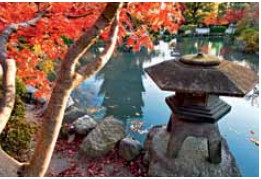
A traditional toro stone lantern stands at the edge of the garden pond (with a reflection of the wooden five-storied pagoda) amidst autumn foliage at Toji Temple, a World Heritage Site.
A BRIEF HISTORY OF JAPANS ANCIENT CAPITAL

The top-knotted head of a warrior bowing to the Emperor.
The city of Kyoto began to take shape in the 8th century when some of its earliest residents, the Hata family, invited the Emperor to make his home on their hunting grounds. Under the most rigorous dictates of geomancy, planners created a grid of roads patterned after the western Chinese city of Xian, terminus of the Silk Road.
Rich with game, traversed by rivers and sheltered on three sides by mountains, Kyoto began its transformation into one of the great cities of the 9th century. By the late 800s, the network of avenues and byways had become the new Imperial Capital. Workers who lived in rough huts helped build a palace and estates for the nobility. A political court thrived on ritual, bureaucratic intrigue, poetry and the newly introduced spiritual practices of Buddhism, a faith introduced to the former court in Nara.


